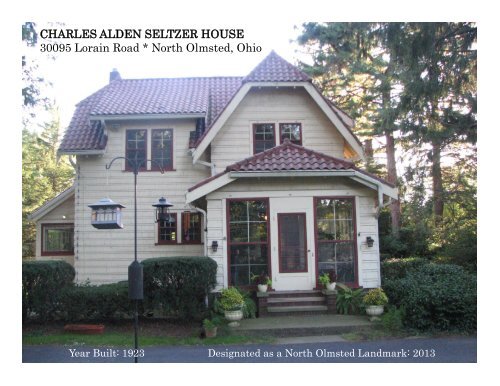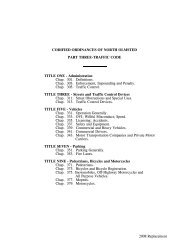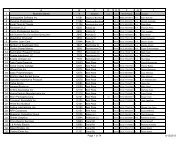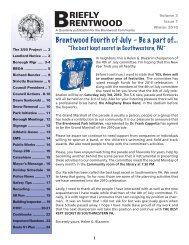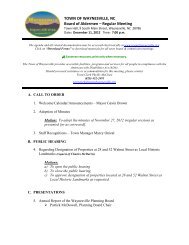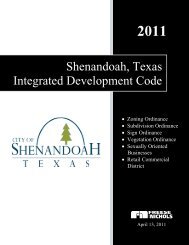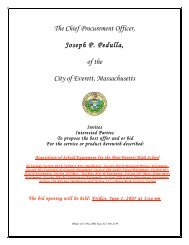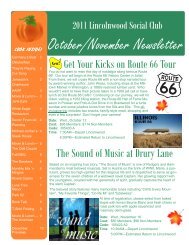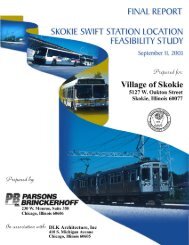CHARLES ALDEN SELTZER HOUSE 30095 Lorain ... - E-Gov Link
CHARLES ALDEN SELTZER HOUSE 30095 Lorain ... - E-Gov Link
CHARLES ALDEN SELTZER HOUSE 30095 Lorain ... - E-Gov Link
Create successful ePaper yourself
Turn your PDF publications into a flip-book with our unique Google optimized e-Paper software.
<strong>CHARLES</strong> <strong>ALDEN</strong> <strong>SELTZER</strong> <strong>HOUSE</strong><br />
<strong>30095</strong> <strong>Lorain</strong> Road * North Olmsted, Ohio<br />
Year Built: 1923 Designated as a North Olmsted Landmark: 2013
TABLE OF CONTENTS<br />
Landmark Commission Statement<br />
Who is Charles Alden Seltzer?<br />
History and Design of the House<br />
Early Development and Context<br />
The Charles Alden Seltzer House<br />
Later History of the House<br />
Early Post Office and Air Beacon<br />
Attachments
LANDMARK COMMISSION STATEMENT<br />
The Landmarks Commission of the City of North Olmsted has researched and assembled<br />
the documented historical information contained in this Landmark Designation Proposal.<br />
The Commission recommends that the Charles Alden Seltzer House be designated as a<br />
Landmark and a plaque signifying such status be affixed to the front of the house.<br />
This process followed for Landmark Designation was in conformance with the Charter and<br />
Codified Ordinances of the City of North Olmsted, specifically Chapter 165, Landmarks<br />
Commission, Section 165.05 DESIGNATION OF LANDMARKS, which states:<br />
(a) A building or other structure may be designated by the Commission as a landmark<br />
if the Commission determines, on the basis of the evidence before it, that the<br />
building or other structure meets two (2) or more of the following criteria:<br />
(1) It has character, interest or value, as part of the development, heritage or<br />
cultural characteristics of the City, State or Nation:<br />
(2) It is the site of an historic event with an effect upon society:<br />
(3) It is identified with a person or group of persons who had some influence<br />
on society; or<br />
(4) It exemplifies the cultural, political, economic, social or historic heritage<br />
of the community.<br />
The features of the Charles Alden Seltzer House, in combination with the contributions of<br />
Charles Seltzer in North Olmsted, Ohio, and in the nation, provide evidence that the property<br />
in question specifically meets the criteria (1), (3), and (4) as listed above necessary<br />
for the designation of Landmark status.<br />
Charles Alden Seltzer was a notable figure in the history of North Olmsted and the nation.<br />
He made significant contributions in his capacity as a council member and two-term<br />
mayor of the community, undertaking new initiatives and improving community services<br />
that benefitted North Olmsted residents during the challenging times of the Great Depression.<br />
Also, as author of dozens of western stories and novels, Charles Alden Seltzer was<br />
widely published and later made inroads into the burgeoning film industry. A number of<br />
his stories became feature films in the early days of Hollywood, first silent films and later<br />
talkies. The Seltzer property itself has a combination of unique architectural design features<br />
not found in properties elsewhere in North Olmsted. It was the site where Mayor<br />
Seltzer held mayor’s court, developed his plans to create a municipal bus line, and made<br />
other decisions that would have a broad impact on the community.<br />
This Landmark Designation Proposal is hereby submitted to the North Olmsted Planning<br />
and Design Commission and the North Olmsted City Council, for their review and approval<br />
for the granting of Landmark Status to the Charles Alden Seltzer House.
WHO WAS <strong>CHARLES</strong> <strong>ALDEN</strong> <strong>SELTZER</strong>?<br />
Charles Alden Seltzer is best known as a nationally-recognized author who wrote at least<br />
40 western novels and quite a few western short stories, and one book on economics. 1 His<br />
stories were mainly published in the Argosy, 2 the best-known pulp magazine covering<br />
western stories, and many others. 3 He also was the writer for 16 Hollywood films, some of<br />
which were based on his novels. 4 Charles wrote under the pen name Hiram Hopkins on<br />
occasion. 5 He was mayor of North Olmsted (1930-1935) 6 for two terms where he built a<br />
very unique house. Mayor Seltzer is often remembered for creating the North Olmsted<br />
Municipal Bus Line, but there are many other examples in historical records where he<br />
changed the status quo or battled powerful companies to protect North Olmsted residents.<br />
One of his sons, Louis Seltzer, became the editor of the Cleveland Press and editor-in-chief<br />
of Scripts-Howard Newspapers of Ohio and appeared on the cover of Life magazine.<br />
Charles was born in Wisconsin on August 15, 1875, but spent most of his life in Ohio or<br />
traveling in the west, with five influential years on an uncle’s ranch in Union County, New<br />
Mexico. He had a long list of occupations before his career in writing took off and even<br />
while writing, especially for a man whose formal education ended in the second grade, 7<br />
and who, as a child, ran away from home and joined the circus. 8 While still a child, he was<br />
a steeplejack’s assistant, a floorwalker in a five and dime, and a railroad brakeman. 9<br />
As a teenager, Charles lives on his uncle’s Union County, New Mexico ranch, working as a<br />
cowpuncher. 10 Around this time, a number of towns have united in their desire to separate<br />
from their respective counties, feeling isolated and unrepresented, situated long distances<br />
from their county seats. 11 Together they create a new county called Union County<br />
in New Mexico territory. Statehood is two decades away. Once the bill creating Union<br />
County passes, a power struggle takes place with several towns competing to be the county<br />
seat. The town of Clayton wins out, due to its proximity along the railroad and its hasty<br />
construction of a new courthouse. The Clayton Town Company is said to have exerted undue<br />
influence to have the courthouse built in a location favorable to it, not town residents.<br />
12<br />
1. The Cleveland Press, February 10, 1942. After spending 17 months of research, Mr. Seltzer used an unknown British publisher and said of his book “What I<br />
want to do is bring people to their economic senses… After the war is over, people will have plenty of time to think about the laws of economics. They had<br />
better starting about them pretty soon if the want to save this civilization”<br />
2. Argosy editions with Charles Alden Seltzer authorship: 9/22/17-11/10/17, 3/30/18-5/4/18, 9/14/18, 11/23/18-12/28/18, 1/18/19, 7/19/19, 11/1/19-<br />
12/6/19, 3/13/20-3/27/20-4/24/20, 8/28/20-9/11/20, 3/5/21, 4/2/21, 11/5/21, 6/17/22-6/24/22, 8/4/23, 8/18/23-8/25/23, 3/15/24, 7/19/24-<br />
7/26/24, 1/17/25-1/31/25, 2/7/25-2/14/25, 4/20/25–5/25/25, 8/15/25, 8/29/25, 9/17/25, 5/22/26, 4/2/27, 11/17/28, 12/8/28, 4/20/29-5/4/29,<br />
5/25/29, 5/15/26-5/29/26, 6/12/26, 3/20/30, 4/5/30, 4/26/30, 8/29/31-10/3/31, 6/18/32-7/23/32, 10/22/32, 6/24/33 - 8/5/33, 8/4/34 - 9/8/34.<br />
3. http://en.wikipedia.org/wiki/Charles_Alden_Seltzer and http://www.philsp.com/homeville/fmi/s3122.htm#A100699. Some of the other ‘pulps’ that Mr.<br />
Seltzer published in were Adventure, Complete Novel Magazine, Blue Book, Double-Action Western, Giant Western, Golden West, Grit, The Outing Magazine,<br />
Pearson's Magazine (US edition), The Popular Magazine, The Railroad Man’s Magazine, Real Western, Short Stories (US and UK editions), Thrilling Ranch<br />
Stories, Thrilling Western, Triple Western Magazine, and Western Story Magazine.<br />
4. http://www.imdb.com/name/nm0783541/<br />
5. CATALOGUE OF TITLE ENTRIES of BOOKS AND OTHER ARTICLES ENTERED IN THE OFFICE OF THE REGISTER OF COPYRIGHTS, LIBRARY OF CONGRESS,<br />
AT WASHINGTON, D.C., UNDER THE COPYRIGHT LAW, WHEREIN THE COPYRIGHT HAS BEEN COMPLETED BY THE DEPOSIT OF TWO COPIES VOL. 28 Third<br />
quarter, 1901 documents that Seltzer used this pseudonym for “Sparks of Fun. A Series of Humorous Lectures” available from the University of Minnesota.<br />
“Flashes of wit from the Buffalo Show” is available from USC Special Collections Rare Books and San Francisco Public Library. Both were published by Sparks<br />
of Fun Publishing Co, Cleveland Ohio. An archive copy is available at http://archive.org/stream/catalogoftitlee190128libr/catalogoftitlee190128libr_djvu.txt
In the mid 1890s, Charles travels back east, where he finds work as a typesetter and a<br />
writer for small town newspapers in a number of towns along the Mississippi River 13 before<br />
settling in Cleveland. He forms a contracting business as carpenter and painter. On<br />
July 28, 1896, Charles marries Ella Albert 14 in Cuyahoga County, Ohio. Between 1897 and<br />
1908, five children are born to the couple: Louis, Robert, Helen, Charles Jr., and Edna.<br />
The first known western fiction by Charles Alden<br />
Seltzer is a story called “The Council of Three” in<br />
1900. 15 This never sold however. An often repeated<br />
story of Charles’ early writing is that the family was<br />
so poor that they could not afford writing paper, so<br />
Ella obtained butcher paper for him to write on.<br />
That paper was provided free by Mr. Belz, probably<br />
from a butcher shop at 2935 Fulton Road. 16 At the<br />
time, the Seltzers lived nearby in a small house on<br />
Seymour Avenue with no electricity. Charles’ father<br />
also lived in the house and would send young grandson<br />
Lou across the street to Noss’ Saloon at 2900<br />
Fulton Road for pails of beer. 17 It was about 1908,<br />
and Charles had just sold his first short story, “Mary<br />
Jane’s Diversion,” which appeared in Golden Stories.<br />
18 Charles was now a building inspector for the<br />
city of Cleveland.<br />
Eight years passed between Charles’ first known<br />
story written and his first story sold; however, this<br />
gap was not due to a lack of trying. While sources vary on the number of stories he wrote<br />
during this time period, a conservative estimate is that Charles wrote at least 100 stories<br />
before he sold one. For someone writing under oil lamps on butcher paper, facing rejection<br />
from publishers over many years, this is an amazing level of persistence.<br />
6. Note that many printed and online sources have this date wrong, but this was verified using actual ordinances signed by Mayor Seltzer. Even the Cleveland<br />
Press obituary for Charles Alden Seltzer and “Cleveland: The Making of a City” (normally authoritative sources) had the wrong years.<br />
7. “The Years Were Good” by Louis B. Seltzer, Page 29<br />
8. The Years Were Good Page 29. The Sells-Floto circus to be specific, working as a water boy for the elephants. More on Sells Floto: http://en.wikipedia.org/<br />
wiki/Sells_Floto_Circus<br />
9. The Years Were Good Page 29<br />
10. The Years Were Good Pages 29 and 287<br />
11. http://www.nmgs.org/artUnionCoHist.htm<br />
12. Both http://www.nmgs.org/artUnionCoHist.htm and http://www.newmexicohistory.org/filedetails.php?fileID=24099 document this.<br />
13. The Years Were Good Page 29<br />
14. In early public records, Ella’s maiden name is Albert, but it is Alberts later.<br />
15. The Cleveland Public Library and Kent State University have a copy of this on microfilm http://clevnet.bibliocommons.com/item/<br />
show/800555048_the_council_of_three and http://olc1.ohiolink.edu/search~S0?/t%22The+Council+of+Three%22/tcouncil+of+three/1%2C1%2C3%2CB/<br />
frameset&FF=tcouncil+of+three&2%2C%2C3<br />
16. The Years Were Good Page 24 cross referenced with the 1906 Cleveland City Directory<br />
17. The Years Were Good Page 39 cross referenced with the 1906 Cleveland City Directory<br />
18. Available via the Gutenberg Project here: http://www.gutenberg.org/files/19356/19356-h/19356-h.htm#MARY_JANES_DIVERSION
Father now lived in a growing westerly suburb. He had a<br />
big rambling house with a red tile roof, and about fifteen<br />
acres of land. Back of the house he built a skeet arrangement<br />
where he would spend hours shattering the<br />
discs as an automatic device sprung them into the air.<br />
He liked for my brothers to join him, and when they were<br />
out on the skeet range their laughter came rolling back<br />
toward the house.<br />
Father had two repressed desires. He wanted to be a<br />
successful businessman and he wanted to get into politics.<br />
The family tried to dissuade him from either venture,<br />
but he persisted.<br />
His books were making him a great deal of money and<br />
he wanted to invest some of it. He decided to convert<br />
part of his land into a gigantic chicken hatchery and<br />
invested many thousands of dollars in the enterprise,<br />
obtaining the best equipment and superintending the job<br />
himself. But it didn't work. He was philosophical about it.<br />
"I got taught a lesson," he said. "It was an expensive<br />
one. I won't repeat that."<br />
But he did. He got interested in an oil-burning furnace<br />
that looked good, obtained a franchise on it for a large<br />
region, put together an organization, and set up offices.<br />
He went at it with the same enthusiasm and energy he<br />
had expended on the chicken hatchery. Like the chicken<br />
hatchery it didn't work out.<br />
"The child went back and got his fingers burned a second<br />
time," he said, in his almost shy, modest way, a<br />
curiously charming characteristic for a man so big in<br />
physical stature, and so successful with his writing.<br />
Father was cured of business. That left one other field of<br />
desire yet unexpressed -- politics. He was tremendously<br />
interested in the little municipality in which he had built<br />
his home. He saw many things that needed to be done<br />
and he decided to run for Mayor to help accomplish<br />
them.<br />
An excerpt of The Years Were Good: The Autobiography of<br />
Louis B. Seltzer by Louis Seltzer<br />
Like another well-known western author, Zane Grey, 19 Charles Alden Seltzer lived in the<br />
east and material for stories had to be researched. Lou Seltzer describes his father as being<br />
a perfectionist:<br />
“He wanted every item of descriptive matter, every<br />
article of wearing apparel, precise and indisputably<br />
correct. He studied about western horses, idioms,<br />
ranches, traditions, history, geology, towns, places…<br />
his early books were… the result of meticulous and<br />
painstaking research.” 20<br />
With success, eventually the Seltzers move to a house with<br />
electricity on 39 th Street at Archwood. Then in June, 1919,<br />
Charles purchases his first house in Lakewood, Ohio on<br />
Detroit Road at Arthur Avenue. It is likely that around this<br />
time, he becomes a member of one of the Lakewood Masonic<br />
lodges since it is known he was a freemason. 21<br />
By 1923, Charles builds his own house in North Olmsted<br />
on <strong>Lorain</strong> Road at stop 43½ on the interurban railway. Of interest, it is Ella, not Charles,<br />
who signs the title transfer of their Lakewood house in January of 1924. At the same time<br />
as Charles builds his dream house, the now famous Hollywood sign is going up (it read<br />
“Hollywoodland” until 1949). 22 Movies are still silent. And this is the year that he writes<br />
the film Brass Commandments, the first time the film version precedes the novel version.<br />
Charles still has son Charles Jr. and daughter Edna living at home with him, but sons Lou<br />
and Robert and daughter Helen have moved out into their own homes.<br />
Charles tries his hand at business around this time, starting a “gigantic” chicken hatchery<br />
and an oil burner franchise. 23 Neither worked out for him; however, ninety years later, the<br />
chicken house building still lives on as a workshop and the small house used by his gardener<br />
is still heated by an oil burner.<br />
Some Hollywood actors now come to visit Charles at his North Olmsted house, most notably<br />
Hollywood bad boy Harry Carey (the actor, not the sports announcer), and William S.<br />
Hart. 24 Charles has set up a skeet shooting range behind the house, 25 and in Charles own<br />
words,<br />
19. Zane Grey and Charles Alden Seltzer corresponded often - see The Years Were Good Pages 281-283.<br />
20. The Years Were Good Page 289<br />
21. Note the Masonic symbol on his grave<br />
22. http://en.wikipedia.org/wiki/Hollywood_Sign<br />
23. The Years Were Good Page 294<br />
24. The Years Were Good Page 281<br />
25. The Years Were Good Page 293<br />
26. Argosy 3/22/30 available at http://web.archive.org/web/20050110043038/http://pulprack.com/arch/2003/01/charles_alden_s.html<br />
27. The Years Were Good Pages 290-292. More on Johnny Risko: http://boxrec.com/media/index.php/Johnny_Risko
“I have broken ninety-two out of a possible hundred clay targets. In a pistol shoot in<br />
competition -- with a thirty-eight Colt -- at twenty yards I have made a ninety-one and<br />
a quarter per cent target.” 26<br />
Charles starts to follow boxing, traveling to both Dempsey-Tunney bouts, but mainly follows<br />
Johnny Risko, usually attending with Cleveland fire warden Tom Connell. 27 Some of<br />
his new neighbors who are progressives in the Bull Moose Party ask Charles to run for political<br />
office. 28<br />
Elected to city council, Charles Alden Seltzer is sworn in on January 3, 1928. 29 One of his<br />
first actions is to use his connections with area fire chiefs to audit the North Olmsted fire<br />
department. Legislation he introduces at various meetings creates the first North Olmsted<br />
fire house, purchases the first pumper truck and hose, and provides training to the volunteer<br />
force. 30 As a result of these improvements, fire insurance rates are cut in half, in effect<br />
making this insurance affordable to some North Olmsted residents for the first time. 31<br />
Councilman Seltzer is known to visit the new fire station regularly. The daughter of one of<br />
the volunteer firemen he befriends, Beryl Peck, becomes owner of the Seltzer house in<br />
1959. 32<br />
There is substantial controversy during Councilman Seltzer’s two year service. Ordinance<br />
232 introduced on April 3, 1928 by Councilman Seltzer allows for Cleveland Electric Illuminating<br />
Company (municipally owned, the very one that Dennis Kucinich fought to keep<br />
30 years later) to provide electricity to North Olmsted residents. The issue with this piece<br />
of legislation is that at the time Mayor Coe sits on the board of the train company that supplies<br />
North Olmsted with electricity. 33 On first reading of the legislation, no council member<br />
other than Charles votes for it and it fails to pass on all future readings. Two city council<br />
meetings after it fails, Councilman Seltzer introduces identically worded Ordinance 243<br />
that the meeting minutes of June 19, 1928 simply record as passing unanimously.<br />
What could explain this change of heart within a two week period by all council members?<br />
The answer is in the Plain Dealer, reporting that Councilman Seltzer moved the city council<br />
meeting out of a small room into larger Town Hall and that “more than 300 villagers” attended<br />
that meeting. 34 This wasn’t a new strategy for Charles, in light of the 1912 plot of<br />
The Coming of the Law, a story in which a newcomer to town uses the newspaper to<br />
achieve justice when corruption and abuse of power block any other means.<br />
28. Cleveland Plain Dealer 12/14/29 page 5<br />
29. North Olmsted City Council Meeting minutes 1/3/28<br />
30. North Olmsted City Council Meeting minutes, especially 2/7/28, 4/3/28, 6/5/28, and 4/1/29. Fire chief Wise of Medina ends up being the most helpful.<br />
North Olmsted residents may wonder which one of the current fire halls was the original, and the answer is neither; the fire house Councilman Seltzer sponsors<br />
is centrally located in North Olmsted and was torn down when the additional fire stations were built. A picture of the original is currently available at<br />
http://www.orgsites.com/oh/iafflocal1267/img231.1.JPG.jpg<br />
31. Cleveland Plain Dealer 12/14/29 page 5<br />
32. Frank Heiser is later appointed Fire Chief of North Olmsted once Charles becomes mayor. Beryl Heiser comes with her father Frank to the Seltzer house at<br />
some point for a visit.<br />
33. Cleveland Plain Dealer 12/14/29 page 5<br />
34. Cleveland Plain Dealer 12/14/29 page 5<br />
Article appearing in the December 14, 1929 edition of the<br />
Plain Dealer, just weeks before Charles Alden Seltzer takes<br />
office as mayor of North Olmsted
Seltzer opposed prohibition<br />
before taking office as mayor<br />
in April 1929. In July 1930 he<br />
issued a search warrant authorizing<br />
a raid on a suspected<br />
North Olmsted speakeasy.<br />
Following adoption of the legislation, the change in electricity providers causes rates to<br />
drop by 25 percent. 35 Next, Councilman Seltzer proposes legislation limiting the fare that<br />
the train company can charge North Olmsted residents. Soon, the train company responds<br />
to city council with a rate reduction. 36 Councilman Seltzer organizes a transportation<br />
council, essentially a partnership with neighboring Fairview Park to work together toward<br />
affordable transportation. When Councilman Seltzer asks Mayor Coe and Councilman<br />
Christman to participate, they refuse, 37 as does Councilman Schindler, saying he is<br />
“opposed to bus lines.” 38 Councilman Seltzer proposes legislation in 1929 to form a municipally-owned<br />
bus line. The proposal is soundly rejected.<br />
Councilman Seltzer was not one to avoid conflict if he thought someone wasn’t doing right.<br />
There are at least two meetings where he moved that the city engineer be found incompetent<br />
– during meetings when the city engineer was presenting status updates.<br />
Beyond North Olmsted politics, Charles Alden Seltzer takes a clear position on another<br />
controversial topic of the day – prohibition. In April 1929, he publicly joins a list of a couple<br />
hundred authors against prohibition. 39<br />
Late in 1929, Charles Alden Seltzer runs for mayor of North Olmsted on a reform platform.<br />
He is elected and signs his first piece of legislation on January 2, 1930. 40 He holds Mayor’s<br />
Court in his house. The most common offense is for speeding on <strong>Lorain</strong> Road, with a number<br />
of tickets showing speeds of 55 mph. If unable to pay with cash, people pay fines with<br />
whatever they have of value such as violins, watches, etc.<br />
Despite his public stance on prohibition, Mayor Seltzer organizes at least two speakeasy<br />
raids with Marshal George Christman, both on <strong>Lorain</strong> Road near the Town Hall. One occurs<br />
on July 3, 1930 at the Congalton residence, just east of Dover Center Road on the<br />
north side of the street; the other occurs near Porter Road. A newspaper article notes that<br />
the reason for suspicion was a sign that listed chicken dinners sold at the estate at too high<br />
a price.<br />
Mayor Seltzer’s next challenge comes on February 20, 1931, when the railway company<br />
serving North Olmsted announces it has gone bankrupt and will be ending service. Mayor<br />
Seltzer organizes a municipally-owned bus service and puts it quickly in place despite the<br />
opposition during the 1929 attempt. However, the city has no money for buses. Mayor<br />
35. Cleveland Plain Dealer 12/14/29 page 5<br />
36. North Olmsted City Council Meeting Minutes 5/21/29<br />
37. North Olmsted City Council Meeting Minutes 4/16/29<br />
38. North Olmsted City Council Meeting Minutes 4/16/29<br />
39. Cleveland Plain Dealer 4/29/29 page 4. The list also includes Edgar Rice Burroughs and F. Scott Fitzgerald.<br />
40. Resolution 1930-445 created the position of city solicitor.
Seltzer buys the first two buses himself. 41 The first run is on March 1, 1931, starting at<br />
John Schindler’s garage at the western end of <strong>Lorain</strong> Road in North Olmsted ending at the<br />
intersection of West 3 rd and Superior in Cleveland. Driven by Robert Dunford, Mayor Seltzer<br />
is onboard, along with the other members of the transportation committee that now<br />
include Councilman Schindler and newly elected Councilman Decker. 42<br />
The city of Cleveland and a remaining railway company both immediately sue. After years<br />
of court battles, all the way to the Ohio Supreme Court, North Olmsted retains the right to<br />
operate its bus line. 43<br />
Just over six months later in 1931, in the midst of the Great Depression, Mayor Seltzer<br />
hands over a list of able-bodied North Olmsted residents to Cuyahoga County for a ditch<br />
digging project. 44<br />
By 1933, Mayor Seltzer may have had enough of politics. The Cleveland Plain Dealer reports<br />
that he resigns on January 26, 1933. 45 However, nothing appears in City Council’s<br />
meeting minutes about this. Mayor Seltzer’s last piece of signed legislation is on December<br />
31, 1935, 46 several years later.<br />
Before the end of his term as mayor, the Cleveland Press interviews him to summarize his<br />
accomplishments. Besides the notable events of his term, he makes one interesting remark<br />
not printed elsewhere, “All the villages west of Rocky River might easily become one,<br />
without losing too much of their personality.” 47 Was this remark based on his experiences<br />
in Union County, New Mexico?<br />
Mayor Seltzer saw North Olmsted through the Great Depression and Prohibition. He created<br />
the first bus line owned by the city when the train line serving the community went<br />
bust and purchased the first buses with his own money. His legislation created the first<br />
fire station, purchased the first pumper truck, and provided the first fire training. He<br />
sought out a new electricity provider to reduce rates. In retrospect, he is one of the most<br />
accomplished and historically significant mayors of North Olmsted. He served six years,<br />
while the man who replaced him, Mayor Gross, lasted only six days. 48<br />
In 1936 Charles’ first talkie is produced, Silver Spurs, starring Buck Jones, which is also the<br />
last film he wrote. He is invited out to Hollywood/Universal Studios for the production,<br />
41. Interview with Grace Oring (secretary for Mayor Seltzer) in Olmsted Historical Society records<br />
42. Cleveland Plain Dealer, March 2, 1931 Front Page<br />
43. North Olmsted’s right to operate its bus line prevailed in the Common Pleas Court and was affirmed on appeal, exempting the Village from regulations<br />
imposed by the City of Cleveland and the railways’ franchise claim. In 1935 the Ohio Supreme Court ultimately sustained Cleveland’s regulatory authority but<br />
the ruling did not diminish North Olmsted’s authority to operate its bus line, in general, and rejected the Railway’s claim. Cleveland Ry Co. v Village of North<br />
Olmsted, 130 Ohio St. 144 (1935).<br />
44. Cleveland Plain Dealer, September 8, 1931, Page 3<br />
45. Cleveland Plain Dealer, January 26, 1933, Page 3<br />
46. Resolution 1935-757, requesting a release of security to Cleveland Trust Company of Cleveland.<br />
47. Newspaper clipping available from Olmsted Historical Society<br />
48. 1/7/36 City Council meeting minutes<br />
The Cleveland Interuban Railroad, early <strong>Lorain</strong> Road<br />
and the first North Olmsted Bus Line bus
ut does not go at the urging of his wife who seems to be concerned<br />
about Anna Q. Nilsson’s impact on ‘Charley.’ 49 Silver Spurs is the only<br />
film still available to the general public today. Square Deal Sanderson is<br />
retained in a couple film archives, and one reel of Riddle Gawne is available<br />
in a Russian film vault.<br />
The Hollywood Walk of Fame hasn’t come into being yet, but by this 13 th<br />
film, over a dozen actors and actresses with a current star have acted in<br />
at least one film written by Charles Alden Seltzer: Buck Jones, William S<br />
Hart, Tom Mix, Lon Chaney, George Hayes, John Bowers, Katherine Mac-<br />
Donald, Alan Hale, Alice Calhoun, William Farnum, Helen Ferguson, and<br />
Lloyd Bacon.<br />
Charles continues to write until 1942, when he becomes very ill from<br />
diabetes. He refuses hospital care at first. The family gathers and persuades<br />
him otherwise. As he leaves the house he built for the last time<br />
to be taken to the hospital, perhaps feeling his end was near, he waves to<br />
his son Lou and speaks his last known words, “So Long, Sucker,” 50 the<br />
title of his last book. On February 9, 1942, Charles Alden Seltzer passes<br />
away at the age of 66.<br />
49. The Years Were Good Pages 286-287<br />
50. The Years Were Good Page 298
Left: Buck Jones was one of the greatest B-western stars of his day, appearing<br />
in Silver Spurs, Chain Lighting, Roughshod, Forbidden Trails,<br />
and The Coming of the Law. He first joined the film industry as a stuntman<br />
and bit player, drawing on his real life experience as a cowboy on a<br />
ranch in Oklahoma. His star on the Hollywood Walk of Fame is located<br />
at 6834 Hollywood Boulevard.<br />
Top Right: Called by many “the original screen cowboy,” William S. Hart<br />
was in Seltzer’s stories-turned-films Square Deal Sanderson and Riddle<br />
Gawne. His home in Newhall, California was built in Spanish Colonial<br />
Revival style starting in 1924. His star is located at 6363 Hollywood<br />
Boulevard.<br />
Middle Right: Katherine MacDonald appeared with William S. Hart in<br />
Riddle Gawne. She was a model turned actress and later was one of the<br />
first female producers in Hollywood. Her star at 6777 Hollywood Boulevard.<br />
Bottom Right: William Farnum is known for his role in Seltzer’s Drag<br />
Harlan, as well as the original Ben-Hur. He also starred in another Seltzer<br />
silent film, Brass Commandments. One of the highest paid actors of<br />
his day, Farnum’s star is located at 6322 Hollywood Boulevard.
House and aerial photos are from a 1951<br />
survey of the property<br />
HISTORY AND DESIGN OF THE <strong>HOUSE</strong><br />
Early Development and Context<br />
Beginning operations in 1895, the interurban railroad played a major role in the development<br />
of the community that would become North Olmsted. Residents could work in Cleveland<br />
and return home at night. Farmers benefited because the interurban carried farm<br />
produce to outside markets in Cuyahoga and <strong>Lorain</strong> Counties.<br />
The Village of North Olmsted incorporated in 1909 after voter<br />
approval the previous November. Within its borders were<br />
ten square miles of northern Olmsted Township and four<br />
square miles of southeastern Dover Township known as Coe<br />
Ridge. Town Hall construction began in 1912. Completed a<br />
year later, the building housed all the village offices including<br />
the newly created police department. The construction boom after World War I began to<br />
change the agricultural landscape of the village, but the Great Depression postponed further<br />
significant development until after World War II.<br />
The Charles Alden Seltzer House<br />
Charles Alden and Ella Seltzer purchased the<br />
property in May of 1922. The property contains<br />
two parcels of land owned by the different<br />
generations of the Robb family. Originally,<br />
the Robb family had just one large plot of<br />
land that Jackson Robb obtained from the<br />
Briggs family in May of 1861. Amos Briggs,<br />
one of the original North Olmsted settlers,<br />
obtained this plot from Charles Olmsted in<br />
June of 1832.<br />
The Seltzers built their house in 1923 according<br />
to tax records from 1923 and 1924, when<br />
a major jump in building value is recorded.<br />
Also, the Seltzers sold their Lakewood house<br />
in January of 1924, clearly indicating they had<br />
moved in by then. Tax records indicate a previous<br />
structure on the property in 1923, but<br />
worth little.<br />
The house architecture is a blend of Craftsman<br />
and Spanish Colonial Revival style. The<br />
Year Population<br />
1910 1,030<br />
1920 1,419<br />
1930 2,624<br />
1940 3,487<br />
Source: U.S. Census
exposed rafter tails and walls of cedar-shake define Craftsman architecture, whereas the<br />
combination of a Spanish tile roof with a small front porch defines Spanish Colonial Revival.<br />
Contrary to the archetype, stone pillars and a large front porch are missing from the<br />
Craftsman style, although stone pillars were placed out at the street. Also, Spanish Colonial<br />
Revival has stucco walls, ornaments, and half-round arcades, all of which are missing<br />
from the house.<br />
Highlights of the house include a Spanish tile roof, a stone fireplace that represents all 48<br />
continental states (and in 1923, there were only 48), hardwood floors, extensive oak paneling,<br />
coffered ceilings in several rooms, an elliptical barrel vault ceiling in one wing, a second<br />
floor skylight, and wormy chestnut paneling and hardwood floors in the basement.<br />
The original property consisted of 4.5 acres around the house, a three-bay garage with a<br />
concrete tile roof, a small house for a private gardener, and a pavilion with a cedar roof.<br />
Master carpenter Percy Sprague built the house and master electrician Mr. Calloway wired<br />
it. The property also had a stone fountain and a separate waterfall and small pond.<br />
Later History of the House<br />
Since the Seltzers lived in the house, there have only been three subsequent owners. The<br />
house has seen little change to the exterior since it was built. The ownership history of the<br />
property is as follows:<br />
1. In December 1942, Mark and Orra Gardner purchased the house from Ella Seltzer.<br />
The Gardners owned a hardware store in nearby <strong>Lorain</strong> County.<br />
2. In February 1959, Clark and Beryl Peck purchased the house from the Gardners. Clark<br />
Peck was a professor at the Case Western Reserve University School of Dentistry, and<br />
many Cleveland area dentists learned from him. He was also on the North Olmsted<br />
School Board. Both of the Pecks were<br />
very active in the community as well.<br />
3. In August 2009, James Morse and<br />
Daniel Hocevar purchased the house<br />
from the Pecks.<br />
Updates by the Seltzers<br />
The fireplace wasn’t completed at the<br />
time the Seltzers moved in, as a story<br />
has been handed down homeowner to<br />
homeowner of how Ella complained<br />
about all the dust while it was being<br />
constructed. A few years after the
house was constructed, Charles started a chicken business and erected a chicken house,<br />
mentioned in a book by Louis Seltzer. In 1930, the Seltzers changed the east screen porch<br />
into an enclosed space, with the story being Ella wanted a room for non-native plants.<br />
Updates by the Gardeners<br />
In 1945, the back door entrance area and small entrance were reworked into a breakfast<br />
nook. All that is visible from the outside since the roof wasn’t changed is a missing eave on<br />
the south side of the breakfast nook where the wall was pushed out one foot, and the eave<br />
is small on the east side, where the wall was pushed out a half foot. The exterior paint color<br />
scheme was also changed.<br />
On the inside, the Gardeners added built-ins to the dining room. They also removed doors<br />
between the living and dining room and changed several doors, and updated the electric<br />
systems. Concerning the rest of the property, they installed a large cistern, moved the<br />
chicken house behind the garage to become one building, and sold over an acre of land to<br />
North Olmsted schools.<br />
Updates by the Pecks<br />
The Pecks added a party room on the end of the chicken house, a shed to the garage, and<br />
added wings to the Pavilion. They installed homemade paneling (the paneling features<br />
book-facing, not possible with machine-made) around the stone fireplace, replacing the<br />
previous large framed red Chinese silk panels which covered the walls. Electric service
was also updated, upstairs air conditioning added, intercom installed, and the kitchen and<br />
bathrooms remodeled. Original wallcoverings were replaced over time.<br />
Updates by Morse/Hocevar<br />
Two basement windows were replaced with glass block that<br />
face the driveway, as one was already broken by ice damage.<br />
An outdoor wood burner was also added near the garage.<br />
For the most part, the original floated glass panes are intact, the<br />
original windows, original redwood-frame storms, and many of<br />
the original screens made of brass. The original skylight had to<br />
finally be replaced. Most of the Ludowici tiles are original and<br />
inside the hardwood floors, radiators and interior floor and ceiling trim is in general original,<br />
excluding kitchen and baths. The house still has the original P&F Corbin locks.<br />
For those into behind the scenes information, the Frank Adams electric panel is likely original<br />
as a 1928 ad from the company shows nearly the identical panel (three others are obviously<br />
updates). Note that Frank Adams was the standard electric equipment provider to<br />
early movie theaters, and Charles Alden Seltzer was very familiar with the film industry.<br />
Lights are controlled (even today) by Swiss-made desparts, not light switches. The basement<br />
stairwell is exactly “house wedge type stringers” in Audels Carpenters and Builders<br />
Guide (popular 1923-1939) and according to carpenters is rarely if ever seen in the area,<br />
and to this day doesn’t squeak (the design’s purpose). Also, there are firestops between<br />
the first and second floors, unusual for 1920’s construction,<br />
and a possible testament to Charles’<br />
building inspection experience.<br />
Charles Alden Seltzer used to describe the property<br />
around his house as a 5-acre private park. He<br />
selected unusual Chamaecyparis pisifera, Cedar,<br />
Juniper, and Larch trees and unusual fruit trees for<br />
the area, besides Norway Spruce, White Pine, and<br />
Chinese Elm. Only one original apple tree remains,<br />
none of the apricot and other odd fruit tree choices.<br />
The current owners had to cut down most of<br />
the remaining Chinese elm, and a ring count confirmed<br />
they dated back to the time the house was<br />
built. Road salt may have killed most of the cedars<br />
near <strong>Lorain</strong> Road, but one remains. However, all<br />
or most of the Chamaecyparis pisifera, Norway<br />
Spruce and White Pine remain, and many appear<br />
in both a 1952 survey picture of the property and a<br />
1938 film.
Air Navigation Map No. 21, Cleveland, Ohio to Chicago, Ill, US<br />
Army Corps of Engineers, prior to the radio range update<br />
Early Post Office Air Mail Beacon<br />
One remaining landscape feature of interest remains – a lighted beacon for Cleveland Municipal<br />
airport on the property from September 1924 until late in 1927. We know about<br />
this beacon because an old pilot informed the Pecks in the 1960’s that the house originally<br />
had the westward beacon for the airport, even before the entire system was operational.<br />
Charles Seltzer, Jr. would have lived in the house at the time and his son, Kim Alden Seltzer<br />
also recalls his father mentioning a beacon placed on the property to help with “the glide<br />
path” into Hopkins. Both of these descriptions exactly fit the original system of lighted beacons<br />
the post office placed when extending the national air route<br />
(New York to San Francisco) to Cleveland, which opened on July 1,<br />
1925 before the rest of the national air route beacon system was in<br />
place. However, no documents exist to fully prove the beacon installed<br />
on the property was one of the original postal beacons. Below<br />
is a summary of what is documented.<br />
There are three relevant acts of Congress to be aware of:<br />
Departments of Commerce and Labor Appropriation bill, 1924,<br />
funding the post office to place beacons for a national air route<br />
H.R. 7064: the Contract Air Mail Bill/Air Mail Act of 1925 or the<br />
Kelly Act, privatizing air mail<br />
1926 Air Commerce Act, which placed all air navigation aids un<br />
der the control of the Bureau of Air Commerce, and establishing<br />
the first aeronautical maps. Only 616 of the beacons placed by<br />
the post office were transferred.<br />
Furthermore, Cleveland Municipal airport was opened on July 1, 1925, as the existing airport<br />
at Martin Field (16800 St. Clair Ave, Cleveland Ohio) could not be used for night landings,<br />
with all three major players (Mr. Martin, Mr. Hopkins, and Mr. Egge) agreeing in written<br />
letters contained at the Western Reserve Historical Society.<br />
The national route went through four revisions during the early years:<br />
1. The first path was unlighted and pilots flew on a specific compass bearing for a length<br />
of time and navigated by street maps. Martin Field was the Cleveland airport at the<br />
time and the air route would have been a bit north of North Olmsted, as the route looks<br />
for the intersection of five rail lines in Elyria and keeps five miles north of that.<br />
2. The second path used beacons between Hopkins and Bryan, Ohio (the next stop). This<br />
one was never documented, but some assumptions can be made comparing to the<br />
third path.
3. The third path was documented by the Bureau of Air Commerce in 1927 after the majority<br />
of post office beacons were decommissioned, and crosses North Olmsted at <strong>Lorain</strong><br />
Road near Christman Drive.<br />
4. The fourth path was created using the radio range, had nothing to do with lighted beacons,<br />
and steered planes a bit north of the North Ridgeville lighted beacon, and therefore<br />
crosses <strong>Lorain</strong> further east near Porter Road and also is documented on 1927<br />
aeronautical maps.<br />
The existence of four air routes is also documented by Ohio Historical Marker 3-86. Bryan’s<br />
Air Mail Field, where this marker is located, was on the first path. The back side of the<br />
marker describes where the airfield moved to on July 1, 1925, and the reason the airfield<br />
moved, which was to align with the lighted beacon path. The marker also describes the<br />
transition to the third national air mail path when many facilities were abandoned and, in<br />
this case, the entire landing field in Bryan was abandoned on September 1, 1927.<br />
There is quite a lot of documentation online describing the first transcontinental air route,<br />
and how beacons were originally spaced every 10 miles, but unfortunately, those web sites<br />
are reporting the first documented route, the third path above. The beacon at the Seltzer<br />
house would have been on the second path above, as was the second airfield in Bryan, and<br />
both were abandoned late in 1927.<br />
The spacing of beacons on the second path is documented as being every 3 miles around<br />
1924, later changed by the Bureau of Air Commerce to a spacing of every 10 miles in a<br />
1927 letter. In short, two-thirds of the beacons on the original Chicago to Cleveland segment<br />
were abandoned and never documented. 51<br />
The Seltzer property is nearly on the line between the North Ridgeville beacon kept by the<br />
Bureau of Air Commerce and Hopkins Airport. It is also just over 3 miles from the airport<br />
beacon, at a high point in the landscape and readily accessible, near a recognizable structure<br />
from the air (the only house with a red tile roof), meeting all the criteria used to place<br />
these beacons. The northeast corner of the Seltzer property is the closest to proper alignment.<br />
In the 1950’s, residents remember a ‘very stout metal flagpole’ being at that corner<br />
of the property. The Pecks recall taking the pole down when it became unstable. The base<br />
of that metal pipe is still visible today. It’s an unproven assumption that this is a remnant<br />
of the original tower, but it is also an unusual location for a flagpole, far off to one side of<br />
the property, and also an unusually large diameter flagpole.<br />
51. http://www.postalmuseum.si.edu/museum/1d_Airmail_Beacon.html The spacing of beacons on the second path is documented by both the Smithsonian<br />
Postal Museum as being every 3 miles, in Letter from C.F. Egge, General Superintendent, Post Office Department, to Mr. T.W. Noblitt, Flat Creek, Tennessee,<br />
February 23, 1924 available on page 14 here http://www.marylouiseclifford.com/sitebuildercontent/sitebuilderfiles/uslhsairways.pdfand in the Cleveland<br />
Plain Dealer May 5, 1925, page 13, and the Cleveland Plain Dealer June 28, 1924 page 18. The Bureau of Air Commerce changed the spacing to every 10 miles,<br />
and a letter went out documenting that change, from F.C. Hingsburg, Chief Engineer, Airways Division, to General Electric Company, September 1, 1927 .
Special thanks to homeowners past and present… Beryl Peck, whose memories have been an<br />
invaluable contribution to this report… and Jim Morse and Dan Hocevar, whose tireless research<br />
and enthusiasm for local history will ensure that the Seltzer story lives on for future generations.


